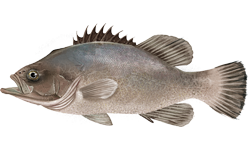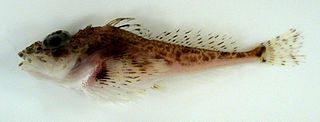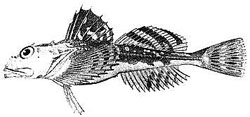
The Cyclopteridae are a family of marine fishes, commonly known as lumpsuckers or lumpfish, in the order Scorpaeniformes. They are found in the cold waters of the Arctic, North Atlantic, and North Pacific oceans. The greatest number of species are found in the North Pacific. The family name Cyclopteridae derives from the Greek words κύκλος (kyklos), meaning "circle", and πτέρυξ (pteryx), meaning "wing" or "fin", in reference to the circle-shaped pectoral fins of most of the fish in this family.

The wreckfish are a family, Polyprionidae in the suborder Percoidei of the order Perciformes.

The scaled sculpins, Icelus, are a genus of marine ray-finned fishes belonging to the family Cottidae, the typical sculpins. Most of the fishes in this genus are found in the northern Pacific Ocean but they also occur in the North Atlantic Ocean.

Cyclopterus is a genus of marine ray-finned fish belonging to the family Cyclopteridae, the lumpsuckers or lumpfish. Its only species is Cyclopterus lumpus, the lumpsucker or lumpfish. It is found in the North Atlantic and adjacent parts of the Arctic Ocean, ranging as far south as Chesapeake Bay on the North American coast and Spain on the European coast. The species has been reported twice in the Mediterranean Sea, off Croatia in 2004 and Cyprus in 2017.

Myoxocephalus is a genus of marine ray-finned fishes belonging to the family Cottidae, the typical sculpins. They are found in the northern Pacific, Arctic and Atlantic Oceans, with a few species in lakes.

Chelidonichthys, the smallscaled gurnards, is a genus of marine ray-finned fishes belonging to the family Triglidae, the gurnards and sea robins. These gurnards are found in the Eastern Atlantic, Indian and Western Pacific Oceans.

The spiny red gurnard is a species of marine ray-finned fish belonging to the family Triglidae, the gurnards and sea robins. This species is found in the northwestern Pacific Ocean where they occur at depths of from 25 to 615 metres. This species grows to a length of 40 centimetres (16 in) TL. This species is of commercial importance as a food fish.

Liparis liparis, the common seasnail, striped seasnail or seasnail, is a small species of marine ray-finned fish belonging to the family Liparidae, the snailfishes, in the order Scorpaeniformes, the scorpionfishes and flatheads. It is found in the northeastern Atlantic Ocean where it lives on the seabed.

Artediellus is a genus of marine ray-finned fishes belonging to the family Cottidae, the typical sculpins. Most of the fishes in this genus are found in the northern Pacific Ocean but they also occur in the Arctic and North Atlantic Oceans.

The smooth lumpfish is a species of marine ray-finned fish belonging to the family Cyclopteridae, the lumpfishes and lumpsuckers. This species is found in the northern Pacific Ocean. It is the only species in the monospecific genus Aptocyclus.
Cyclopteropsis is a genus of marine ray-finned fishes belonging to the family Cyclopteridae, the lumpfishes or lumpsuckers. These small lumpfishes are found in the North Pacific and Arctic Oceans.

Eumicrotremus is a genus of lumpfishes native to the northern oceans. The name for this genus comes from the Greek roots eu meaning "good", mikros meaning "small" or "little", and trema meaning "hole".

Cottunculus is a genus of marine ray-finned fish belonging to the family Psychrolutidae. These fishes are found in the Atlantic, Pacific and Arctic oceans.

The longhorn sculpin is a species of marine ray-finned fish belonging to the family Cottidae, the typical sculpins.This species is found in the Northwest Atlantic Ocean. It is a predatory and scavenging fish that can feed on the remains of other organisms.

Myoxocephalus scorpioides, the Arctic sculpin or northern sculpin, is a species of marine ray-finned fish belonging to the family Cottidae, the typical sculpins. This fish is found in the Arctic Ocean.

The Pacific spiny lumpsucker is a species of bony fish in the family Cyclopteridae.
Eumicrotremus schmidti is a species of lumpfish native to the Northwest Pacific. It is a demersal fish known only from the northern Sea of Okhotsk, where it is found at a depth range of 20 to 143 m. Specimens of E. schmidti were once attributed to the related species E. andriashevi, which does not inhabit the Sea of Okhotsk. This species was first formally described in 1955 by the Soviet ichthyologists Georgii Ustinovich Lindberg and Marina Iosifovna Legeza with its type locality given as Penzhinskaya Bay in the Sea of Okhotsk in Russia. The identity of the person honoured in the specific name was not given by Lindberg and Legeza but it is likely to be Petr Yulievich Schmidt, a Russian ichthyologist.

Stichaeus is a genus of marine ray-finned fishes belonging to the family Stichaeidae, the pricklebacks or shannies. These fishes are mainly found in the North Pacific Ocean with one species in the Arctic and western North Atlantic Oceans.

The Arctic shanny is a species of marine ray-finned fish belonging to the family Stichaeidae, the pricklebacks and shannies. This species occurs in the North Pacific, Arctic and western North Atlantic Oceans.
Eumicrotremus fedorovi is a species of marine ray-finned fish belonging to the family Cyclopteridae, the lumpfishes or lumpsuckers. This species is found in the northwestern Pacific Ocean around the Kuril Islands. It is a demersal fish that occurs at a depth range of 115 to 370 m. This species was first formally described in 1991 by Sergey Anatolyevich Mandritsa with its type locality given as the Rikord Strait. The specific name honours the Russian zoologist Vladimir Vladimirovich Fedorov who studied the holotype and suggested that it represented a new species.




















